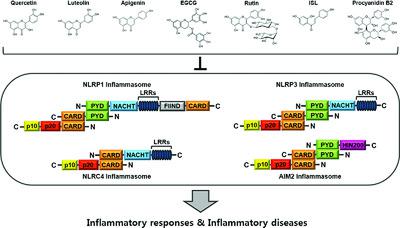当前位置:
X-MOL 学术
›
Mol. Nutr. Food Res.
›
论文详情
Our official English website, www.x-mol.net, welcomes your
feedback! (Note: you will need to create a separate account there.)
Regulatory Roles of Flavonoids on Inflammasome Activation during Inflammatory Responses
Molecular Nutrition & Food Research ( IF 4.5 ) Pub Date : 2018-06-19 , DOI: 10.1002/mnfr.201800147 Young-Su Yi 1
Molecular Nutrition & Food Research ( IF 4.5 ) Pub Date : 2018-06-19 , DOI: 10.1002/mnfr.201800147 Young-Su Yi 1
Affiliation

|
Inflammation is an innate immune response to noxious stimuli to protect the body from pathogens. Inflammatory responses consist of two main steps: priming and triggering. In priming, inflammatory cells increase expressions of inflammatory molecules, while in triggering, inflammasomes are activated, resulting in cell death and pro‐inflammatory cytokine secretion. Inflammasomes are protein complexes comprising intracellular pattern recognition receptors (PRRs) (e.g., nucleotide‐binding oligomerization domain‐like receptors (NLRs), absent in melanoma 2 (AIM2), and caspases‐4/5/11) and pro‐caspase‐1 with or without a bipartite adaptor molecule ASC. Inflammasome activation induces pyroptosis, inflammatory cell death, and stimulates caspase‐1‐mediated secretion of interleukin (IL)‐1b and IL‐18. Flavonoids are secondary metabolites found in various plants and are considered as critical ingredients promoting health and ameliorating various disease symptoms. Anti‐inflammatory activity of flavonoids and underlying mechanisms have been widely studied. This review introduces current knowledge on different types of inflammasomes and their activation during inflammatory responses and discusses recent studies regarding anti‐inflammatory roles of flavonoids as suppressors of inflammasomes in inflammatory conditions. Understanding the regulatory effects of flavonoids on inflammasome activation will increase our knowledge of flavonoid‐mediated anti‐inflammatory activity and provide new insights into the development of flavonoid preparations to prevent and treat human inflammatory diseases.
中文翻译:

黄酮类化合物在炎症反应过程中对炎症小体活化的调节作用。
炎症是对有害刺激的先天免疫反应,可保护人体免受病原体的侵害。炎症反应包括两个主要步骤:引发和触发。在引发过程中,炎症细胞会增加炎症分子的表达,而在触发时,炎症小体就会被激活,从而导致细胞死亡和促炎性细胞因子的分泌。炎性小体是包含细胞内模式识别受体(PRR)(例如核苷酸结合的寡聚化域样受体(NLR),黑素瘤2(AIM2)和caspases-4 / 5/11中不存在)和pro-caspase-1的蛋白复合物。带有或不带有二聚体衔接分子ASC。炎性体的激活会诱导细胞凋亡,炎性细胞死亡,并刺激caspase-1介导的白介素(IL)-1b和IL-18分泌。类黄酮是在各种植物中发现的次生代谢产物,被认为是促进健康和改善各种疾病症状的重要成分。黄酮类化合物的抗炎活性及其潜在机制已得到广泛研究。这篇综述介绍了有关不同类型的炎性体及其在炎症反应过程中的激活的最新知识,并讨论了有关黄酮类在炎性条件下作为炎性体抑制剂的抗炎作用的最新研究。了解类黄酮对炎症小体活化的调节作用将增加我们对类黄酮介导的抗炎活性的了解,并为预防和治疗人类炎性疾病的类黄酮制剂的开发提供新的见解。
更新日期:2018-06-19
中文翻译:

黄酮类化合物在炎症反应过程中对炎症小体活化的调节作用。
炎症是对有害刺激的先天免疫反应,可保护人体免受病原体的侵害。炎症反应包括两个主要步骤:引发和触发。在引发过程中,炎症细胞会增加炎症分子的表达,而在触发时,炎症小体就会被激活,从而导致细胞死亡和促炎性细胞因子的分泌。炎性小体是包含细胞内模式识别受体(PRR)(例如核苷酸结合的寡聚化域样受体(NLR),黑素瘤2(AIM2)和caspases-4 / 5/11中不存在)和pro-caspase-1的蛋白复合物。带有或不带有二聚体衔接分子ASC。炎性体的激活会诱导细胞凋亡,炎性细胞死亡,并刺激caspase-1介导的白介素(IL)-1b和IL-18分泌。类黄酮是在各种植物中发现的次生代谢产物,被认为是促进健康和改善各种疾病症状的重要成分。黄酮类化合物的抗炎活性及其潜在机制已得到广泛研究。这篇综述介绍了有关不同类型的炎性体及其在炎症反应过程中的激活的最新知识,并讨论了有关黄酮类在炎性条件下作为炎性体抑制剂的抗炎作用的最新研究。了解类黄酮对炎症小体活化的调节作用将增加我们对类黄酮介导的抗炎活性的了解,并为预防和治疗人类炎性疾病的类黄酮制剂的开发提供新的见解。











































 京公网安备 11010802027423号
京公网安备 11010802027423号